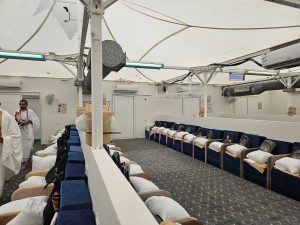FOOD AND ACCOMODATION AT MINA DURING HAJJ

Hosting millions of pilgrims each year, Mina’s Tent City is meticulously organized to provide essential services and comfort during the Hajj pilgrimage. Despite the sheer scale of the gathering, the Saudi authorities ensure that food, accommodation, and sanitation are well-managed and accessible to all.
Tents and Accommodation
Pilgrims are accommodated in large, air-conditioned tents, designed to offer relief from the desert heat. These tents are segregated by gender and are equipped with basic necessities such as sleeping mats and blankets. The organized layout of the tents helps manage the massive crowds efficiently while ensuring pilgrims have a restful stay.
Food Services
A variety of food services are available in Mina to cater to diverse dietary needs and cultural preferences. Pilgrims have the option to bring their own food or rely on nutritionally balanced meals provided by Hajj authorities. These meals are carefully prepared to maintain hygiene and accommodate the health requirements of a global gathering.
Sanitation Facilities
Maintaining cleanliness in Mina is a top priority. Pilgrims have access to well-maintained toilets, showers, and sanitation stations spread throughout the area. Regular cleaning operations are conducted to uphold high hygiene standards, ensuring a healthy environment for all.
Medical Services
Mina is equipped with medical clinics and first aid stations, strategically placed to respond to any health concerns that may arise. Medical personnel receive specialized training to operate in high-demand settings and are prepared to assist pilgrims around the clock.
Despite the overwhelming number of attendees, the infrastructure and coordination in Mina reflect careful planning, ensuring that every pilgrim experiences a smooth and safe journey.
Interesting Facts About Mina
Tent City: Mina is famously known as the “Tent City” due to the presence of more than 100,000 fire-resistant tents, each accommodating dozens of pilgrims.
Historical Significance: It is the site where Prophet Ibrahim (Abraham) was tested by Allah with the command to sacrifice his son Ismail (Ishmael)—a pivotal moment commemorated during Hajj.
Stoning of the Devil (Ramy al-Jamarat): This powerful ritual, performed in Mina, symbolizes the rejection of evil and is a reenactment of Ibrahim’s defiance of Satan’s temptations.
Day of Sacrifice (Eid al-Adha): One of the central rituals in Mina is the Qurbani, the sacrificial offering of an animal in remembrance of Prophet Ibrahim’s devotion to God.
Temporary but Massive: Mina is a temporary city that comes alive each year for a few days, hosting one of the largest annual gatherings of people on Earth.
A Global Unity: Pilgrims from over 180 countries converge in Mina, making it a powerful symbol of Islamic unity, diversity, and shared faith.
Conclusion: The Spiritual Heart of Hajj
Mina is far more than a resting place—it is the spiritual heart of the Hajj pilgrimage. As the location of key rituals such as the Stoning of the Devil and Qurbani, Mina represents submission to Allah, self-discipline, and the unity of the global Muslim ummah.
With its well-organized facilities, from air-conditioned tents to healthcare services, Mina provides pilgrims with the physical comfort needed to focus on their spiritual devotion. The time spent in Mina strengthens the faith of believers and deepens their connection to Islamic values and traditions.
Understanding the role of Mina in Hajj not only enhances one’s knowledge of this sacred journey but also offers a profound appreciation for the sacrifice, history, and unity that define this extraordinary gathering of faith.

